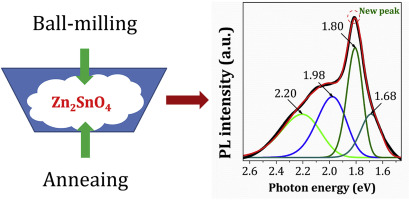当前位置:
X-MOL 学术
›
Opt. Mater.
›
论文详情
Our official English website, www.x-mol.net, welcomes your
feedback! (Note: you will need to create a separate account there.)
A new far-red emission from Zn2SnO4 powder synthesized by modified solid state reaction method
Optical Materials ( IF 3.8 ) Pub Date : 2020-02-01 , DOI: 10.1016/j.optmat.2020.109670 L.T.T. Vien , Nguyen Tu , Manh Trung Tran , Nguyen Van Du , D.H. Nguyen , D.X. Viet , N.V. Quang , D.Q. Trung , P.T. Huy
Optical Materials ( IF 3.8 ) Pub Date : 2020-02-01 , DOI: 10.1016/j.optmat.2020.109670 L.T.T. Vien , Nguyen Tu , Manh Trung Tran , Nguyen Van Du , D.H. Nguyen , D.X. Viet , N.V. Quang , D.Q. Trung , P.T. Huy

|
Abstract In this work, far-red-emitting Zn2SnO4 phosphor has been successfully synthesized by a facile modified solid-state reaction method from ZnO and SnO2 powders. FESEM images reveal that as-milled particles are nearly spherical, with size in the range of 10–30 nm. The particle size increases with increasing annealing temperature and it reaches the value of about 4 μm at 1200 °C. XRD patterns indicate that Zn2SnO4 phase starts occurring at ~700 °C with its single phase at 900 °C and the best crystalline quality of Zn2SnO4 phase is obtained at 1000 °C. UV–Vis spectra analysis reveals that ZnO phase reappears at high annealing temperature (≥1100 °C), reflecting the deterioration of the single phase of Zn2SnO4. A broad visible band centered at 684 nm, which has never been explicitly reported, is clearly observed in the PL spectrum of the single Zn2SnO4 crystals. The intensity of this new band is influenced by annealing temperatures. It reaches the maximum value at 1000 °C, corresponding to the highest quality of the Zn2SnO4 phase. By using data fitting, the PL spectrum is deconvoluted into four Gaussian peaks at ~2.20 eV (563.5 nm), ~1.98 eV (626.1 nm), ~1.80 eV (688.8 nm), and ~1.68 eV (738.0 nm). The peak at ~2.20 eV (563.5 nm) is ascribed to oxygen vacancy (Vo) while the other emission peaks are possibly associated with a significant number of trapped states due to the high concentration of deficiencies such as oxygen vacant defects, zinc interstitials, zinc/tin vacancies (VZn/VSn), Zn/Sn stoichiometry or point defects.
中文翻译:

改良固相反应法合成的 Zn2SnO4 粉末的远红光新发射
摘要 在这项工作中,通过简便的改良固相反应法,从 ZnO 和 SnO2 粉末中成功合成了发射远红光的 Zn2SnO4 荧光粉。FESEM 图像显示研磨后的颗粒接近球形,尺寸在 10-30 nm 范围内。粒径随着退火温度的升高而增加,在 1200°C 时达到约 4 μm 的值。XRD 图案表明 Zn2SnO4 相在 ~700°C 开始出现,其单相在 900°C 时出现,并且在 1000°C 时获得 Zn2SnO4 相的最佳结晶质量。UV-Vis 光谱分析表明 ZnO 相在高退火温度 (≥1100 °C) 下重新出现,反映了 Zn2SnO4 单相的劣化。以 684 nm 为中心的宽可见波段,从未明确报道过,在单个 Zn2SnO4 晶体的 PL 光谱中可以清楚地观察到。这个新带的强度受退火温度的影响。它在 1000 °C 时达到最大值,对应于 Zn2SnO4 相的最高质量。通过使用数据拟合,PL 光谱被解卷积为 ~2.20 eV (563.5 nm)、~1.98 eV (626.1 nm)、~1.80 eV (688.8 nm) 和 ~1.68 eV (738.0 nm) 的四个高斯峰。~2.20 eV (563.5 nm) 处的峰值归因于氧空位 (Vo),而其他发射峰值可能与大量的俘获态有关,这是由于氧空位缺陷、锌填隙、锌/锡空位 (VZn/VSn)、Zn/Sn 化学计量或点缺陷。它在 1000 °C 时达到最大值,对应于 Zn2SnO4 相的最高质量。通过使用数据拟合,PL 光谱被解卷积为 ~2.20 eV (563.5 nm)、~1.98 eV (626.1 nm)、~1.80 eV (688.8 nm) 和 ~1.68 eV (738.0 nm) 的四个高斯峰。~2.20 eV (563.5 nm) 处的峰值归因于氧空位 (Vo),而其他发射峰可能与大量的俘获态有关,因为氧空位缺陷、锌填隙、锌/锡空位 (VZn/VSn)、Zn/Sn 化学计量或点缺陷。它在 1000 °C 时达到最大值,对应于 Zn2SnO4 相的最高质量。通过使用数据拟合,PL 光谱被解卷积为 ~2.20 eV (563.5 nm)、~1.98 eV (626.1 nm)、~1.80 eV (688.8 nm) 和 ~1.68 eV (738.0 nm) 的四个高斯峰。~2.20 eV (563.5 nm) 处的峰值归因于氧空位 (Vo),而其他发射峰可能与大量的俘获态有关,因为氧空位缺陷、锌填隙、锌/锡空位 (VZn/VSn)、Zn/Sn 化学计量或点缺陷。
更新日期:2020-02-01
中文翻译:

改良固相反应法合成的 Zn2SnO4 粉末的远红光新发射
摘要 在这项工作中,通过简便的改良固相反应法,从 ZnO 和 SnO2 粉末中成功合成了发射远红光的 Zn2SnO4 荧光粉。FESEM 图像显示研磨后的颗粒接近球形,尺寸在 10-30 nm 范围内。粒径随着退火温度的升高而增加,在 1200°C 时达到约 4 μm 的值。XRD 图案表明 Zn2SnO4 相在 ~700°C 开始出现,其单相在 900°C 时出现,并且在 1000°C 时获得 Zn2SnO4 相的最佳结晶质量。UV-Vis 光谱分析表明 ZnO 相在高退火温度 (≥1100 °C) 下重新出现,反映了 Zn2SnO4 单相的劣化。以 684 nm 为中心的宽可见波段,从未明确报道过,在单个 Zn2SnO4 晶体的 PL 光谱中可以清楚地观察到。这个新带的强度受退火温度的影响。它在 1000 °C 时达到最大值,对应于 Zn2SnO4 相的最高质量。通过使用数据拟合,PL 光谱被解卷积为 ~2.20 eV (563.5 nm)、~1.98 eV (626.1 nm)、~1.80 eV (688.8 nm) 和 ~1.68 eV (738.0 nm) 的四个高斯峰。~2.20 eV (563.5 nm) 处的峰值归因于氧空位 (Vo),而其他发射峰值可能与大量的俘获态有关,这是由于氧空位缺陷、锌填隙、锌/锡空位 (VZn/VSn)、Zn/Sn 化学计量或点缺陷。它在 1000 °C 时达到最大值,对应于 Zn2SnO4 相的最高质量。通过使用数据拟合,PL 光谱被解卷积为 ~2.20 eV (563.5 nm)、~1.98 eV (626.1 nm)、~1.80 eV (688.8 nm) 和 ~1.68 eV (738.0 nm) 的四个高斯峰。~2.20 eV (563.5 nm) 处的峰值归因于氧空位 (Vo),而其他发射峰可能与大量的俘获态有关,因为氧空位缺陷、锌填隙、锌/锡空位 (VZn/VSn)、Zn/Sn 化学计量或点缺陷。它在 1000 °C 时达到最大值,对应于 Zn2SnO4 相的最高质量。通过使用数据拟合,PL 光谱被解卷积为 ~2.20 eV (563.5 nm)、~1.98 eV (626.1 nm)、~1.80 eV (688.8 nm) 和 ~1.68 eV (738.0 nm) 的四个高斯峰。~2.20 eV (563.5 nm) 处的峰值归因于氧空位 (Vo),而其他发射峰可能与大量的俘获态有关,因为氧空位缺陷、锌填隙、锌/锡空位 (VZn/VSn)、Zn/Sn 化学计量或点缺陷。









































 京公网安备 11010802027423号
京公网安备 11010802027423号